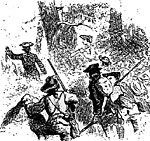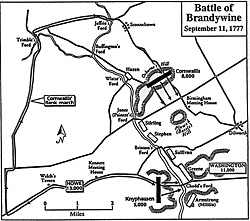
Hesse-Cassel Jaeger Journal Account of Brandywine
The Hesse-Cassel Jaeger Corps journal provides a far more detailed account of the battle:
-
"At daybreak the army moved forward in two columns, the right
under Lieutenant General von Knyphausen, including Major General
lames Grant, took the road to Chadds Ford, seven miles from Kennett
Square, and arrived at ten o'clock in front of the enemy.
 The advance guard of this column, consisting of the Queen's
Rangers, skirmished with enemy outposts as the column moved into
position, and as General von Knyphausen was not to attack before
the left column unda Sir William Howe and Lord Cornwallis attacked
the enemy's right wing, he engaged the enemy only with artillery fire,
as if he intended to force the ford.
The advance guard of this column, consisting of the Queen's
Rangers, skirmished with enemy outposts as the column moved into
position, and as General von Knyphausen was not to attack before
the left column unda Sir William Howe and Lord Cornwallis attacked
the enemy's right wing, he engaged the enemy only with artillery fire,
as if he intended to force the ford.
Large Map Version (slow download: 88K)
Meantime, Sir William Howe marched to the first arm of the Brandywine Creek, a distance of twelve miles. The Jaegas were in the advance guard for this column and were supported by the 1st and 2nd Battalions of Light Infantry, commanded by Lieutenant Colonel Robert Abercromby.
These were followed by the grenadiers. Captain Ewald with fifty jaegers, supported by Captain William Scott with his company of light infantry, had the most advanced postion before the Jaeger Corps. About two miles this side of the Brandywine we met an enemy patrol of 100 men, which retreated into the woods, leaving a few prisoners behind. This force was the one which notified General Washington of our approach and convinced him to change his belief, which up till now, was that our army really intended to cross at Chadds Ford, and to detach the largest part of his army to oppose us.
Meanwhile, we crossed the first arm of the Brandywine Creek at Hinckloss Ford, and the second at Jeffrey's Ford. Here was such a high hill, that 500 men with two cannons could have made passage impossible, or at least, extremely difficult, and since this was not occupied, the general was reinforced in his belief that Washington wanted to retreat and did not wish a battle. Further, that it was not his wish to engage, but that Congress had given him positive orders to attack. It was extremely difficult to move artillery over the height, and therefore the column halted on the opposite side of the height until two o'clock.
After the artillery had been brought over and we could resume our march in columns, in this rather open area, Captain Ewald, about three o'clock, reported the enemy army was marching toward us. Thereupon we received orders to form in line. The advance guard deployed from the middle to the right and left. Ihe Jaeger Corps had the honor to man the extreme left wing and consisted, after the departure of the detachments under Captain Ewald and the cavalry, which because of th difficult terrain could not follow us, of something over 300 men with two English 3-pounders, which were covered by the Hessian Jaeger Lieutenant Balthasor Mertz with thirty grenadiers.
The Hessian Grenadiers supported the right wing, and the 3rd Brigade of Englanders likewise was to support the Jaegers and Light Infantry in the second encounter. But, because of the uneven terrain and the movement toward the left by the column, we saw nothing of it during the battle.
About three-thirty, the Jaeger Corps found itself close to an enemy advance post, with two 6-pounders and 600 men, which stood on a height, with woods in front of it. Our two 3pounders opened fire first, the Jaegers attacked the enemy, drove them into a bush, and dislodged them three different times before they retreated back to the main body of the army.
The main army was advantageously posted on a not especially steep height in front of the woods, with the right wing resting on a steep and deep ravine. This wing was directly opposite the Jaegers, and in the ambushes frm which the Jaegers were engaged for over half an hour, with grapeshot and small arms, with a battalion of light infantry. We could not see the 2nd Battalion of Light Infantry because the of the terrain, and while we received only a few orders, each commander had to act according to his own best judgement.
Meanwhile the firing became more general and stronger, and Lieutenant Colonel von Wurmb heard that the right wing was advancing. Therefore, he had the call to attack sounded on the half moon (hunting horn), and the lancers with the battalion of light infantry stormed up the height. The enemy retreated in confusion, abondoning two cannons and an ammunition cession, which the Light Infantry, because they had attacked on the less steep slope of the height, took possession of. We had no cavalry, our people were very fatigued, and in only a moment, the enemy were out of sight. Therefore, we made no prisoners".
The Jaegers lost Lieutenant Forstner of Ansbach, and six men killed, as well as Hessian laeger Captain Trautvetter, three sergeants, and 35 men severely wounded. Of these the first and many of the latter died. The losses by the Light Infantry were not as great, and of the enemy we saw many dead and wounded.
Thereafter, as the 2nd Battalion of Light Infantry had attacked so far to the right, we stood at a great distance from the army and not until about seven o'clock in the evening, on orders, we were rejoined to the army at Dilworth, where they had encamped on the battlefield rather than continuing in pursuit of the enemy.
Lieutenant Gerneral Knyphausen, according to the agreed upon plan, had advanced over Chadds Ford as soon as he heard firing on our front, taking three cannons and a howitzer in a small redoubt, which was overun, and also forced the enemy into flight. The total losses to the royal army are about 400 dead and wounded. The enemy, on the other hand, is figured to have had 300 killed, 600 wounded, and 400 taken prisoner.
September 14: Today the sick and wounded of the army were sent to Wilmington, escorted by Colonel von Loos with the combined battalion (of Hessian Grenadiers)...
September 16: The Mirbach Regiment marched to Wilmington to provide protection for the hospital."
Rueffer's Account of the Battle
- September 10: According to statement of two spies who encountered a picket, a forward detachment of the enemy consisting of about 1,000 men, mostly cavalry, is only a quarter of an hour away from us and the army is on Brandywine Hill three or four miles from here (a half hour beyond Kings Square).
September 11: This day has earned the right to special recognition because it has given us the greatest glory. At daybreak the entire army marched in two divisions, by half companies, from the right. General Cornwallis' division which the commanding general was with, was on our left. Genaal von Knyphausen's division consisting of the following troops assembled on the road to Welsh Tavern: one officer and fifteen dragoons, the English Jaegers, the 1st and 2nd English Brigades, Stirn's Brigade, the remaining dragoons, 2nd Artillery Brigade, baggage and livestock, and the rear guard consisting of three battalions of the 71st Regiment, of which the 2nd Battalion covered the rear of the baggage, the 3rd Battalion was on the right flank, and the Ist Battalion was on the left flank.
Hardly one and a half miles had been marched when the most advanced regiments were in sharp engagement with the enemy, in which they suffered a great loss. Toward nine o'clock, after the most advanced troops captured one height after another with great difficulty and heavy losses, we received orders not to advance farther and we lay on the heights at Chadds Ford opposite Brandywine Hill, which according to statements by deserters and pnsoners was occuppied by 24,000 men,
[Editor: this just goes to show that you can't trust the information received from pnsoners and deserters, given that Washington's entire army consisted of about 14,000 men at most]
who except for a continuous cannonade, remained unengaged. Also, the Queen's Rangers and English Jaegers were in continuous hand-to-hand combat with the most advanced enemy parties. At one o'clock in the afternoon we heard, on our left wing, the heavy fire by General Cornwallis' Corps, at which instant we moved out and advanced on the enemy's left wing, by Brauntown or Schatzes Ferry, through the Brandywine Hills and seized them, whereupon the enemy retired in great fear, and in a battery from which he had done us much harm and which the 4th English Regiment had stormed, he left a Hessian cannon which had been captured at Trenton, two French cannons, and howitzer.
The approaching dusk prevented our pursuit of the enemy. Therefore we camped on the Brandywine Hills.
The enemy losses are still not known, but certainly so many that their army was scattered during their flight and is near complete collapse. The bravery displayed by all the English troops today, those under the command of General Cornwallis as well as General von Knyphausen, can not be described with too much enthusiasm. Our loss is still not known. Everyone thinks however that it is very large.
The corps commanded by General Cornwallis was also very fortunate, having captured a Hessian cannon lost at Trenton, eleven French cannons, and one howitzer. Stirn's Brigade lost seven men, of whom two of those killed and one man wounded were from our regiment. The Congress had eaten at a house which we passed today, Welsh's Tavern, and they had strongly recommended that their troops hold Brandywine Hill.
September 12: The English headquarters was at Dilworth, the Hessian's at Brauntown, and the field hospital set up at Talbot.
September 13: We remained in the same camp as yesterday. Our losses consist of 58 English and four German officers killed or wounded, including Captain Trautvetter from the Hessian and Lieutenant von Forstner of the Ansbach Jaegers, Lieutenant von Baumbach of the Guards, and Lieutenant Dupuy of the Linsingen Grenadier Battalion, as well as thirty jaegers, of the total loss of 400 men, and on the enemy's side, about 800 men...
September 14: We remained quiet and are occupied with the search for wounded. The Combined Battalion marched toward Wilmington today, escorting a part of the prisoners and the wounded."
Battle of Brandywine Accounts (Part I)
Additional Notes on the Battle of Brandywine
Brandywine Order of Battle
Back to American Revolution Journal Vol. I No. 1 Table of Contents
Back to American Revolution Journal List of Issues
Back to Master Magazine List
© Copyright 1997 by James E. Purky
This article appears in MagWeb (Magazine Web) on the Internet World Wide Web.
Other military history articles and gaming articles are available at http://www.magweb.com